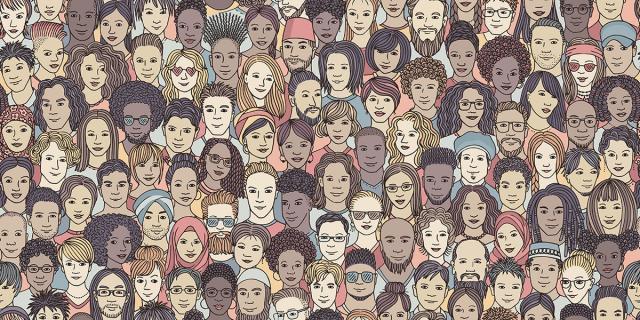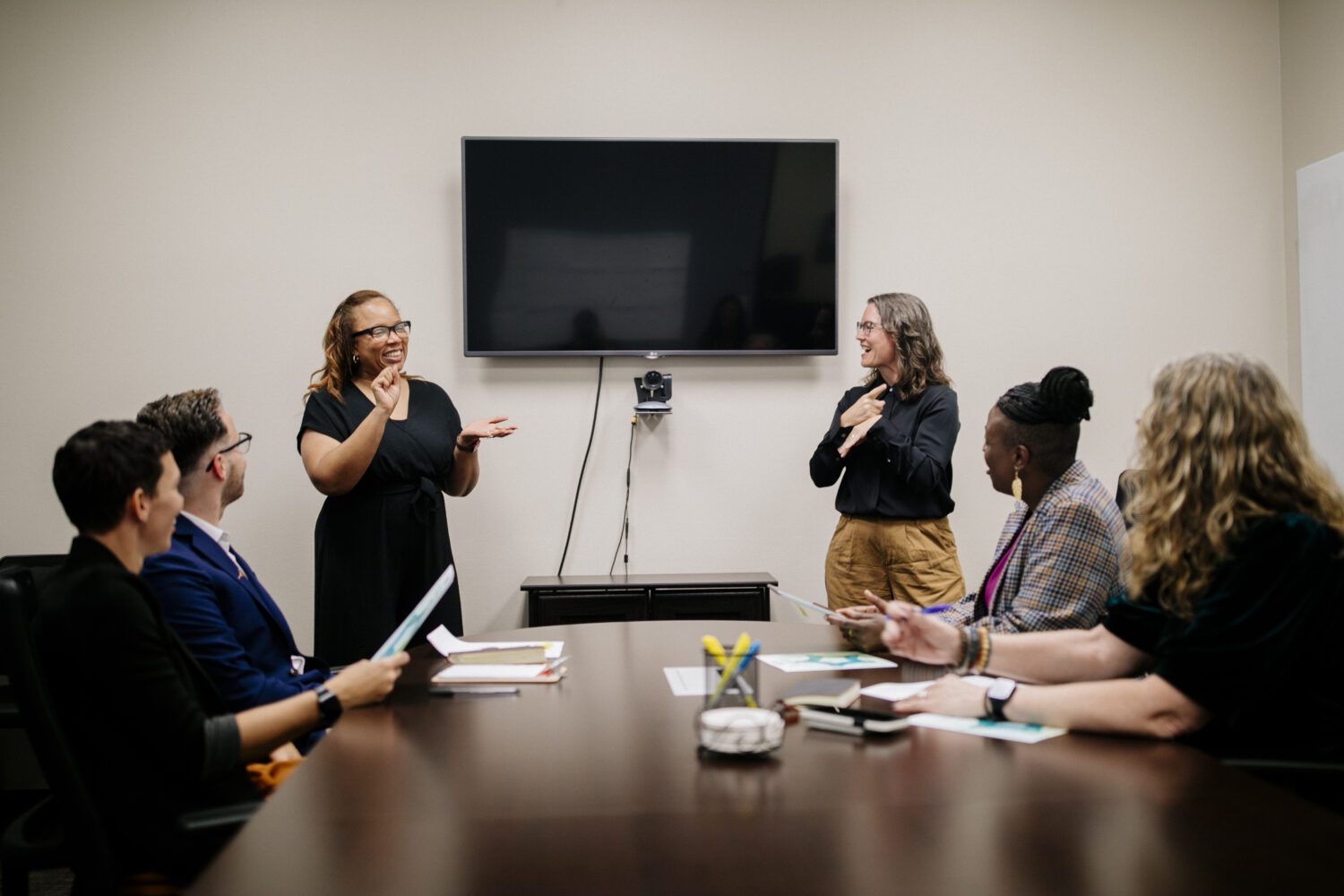Video description
It’s been said that the most meaningful change happens at the local level. But how can local communities involve more deaf people in decision making and let them lead the way in creating positive systemic change?
That was the topic of For Deaf People, By Deaf People: Centering Deaf People in Systems Change, a panel discussion hosted online by the National Deaf Center on Postsecondary Outcomes (NDC) and its Engage for Change | local (EFC) initiative, which work toward improving educational and employment outcomes for deaf people by facilitating community- and deaf-led dialogs across the nation.
The December 8th event gathered hundreds of attendees via Zoom to learn from local deaf leaders, who shared their experiences with EFC | local projects in their communities, discussed the importance of deaf-led systemic change, and explained how they center deaf people in their work.
Deaf people are frequently marginalized
It is a persistent issue. Decisions and policies that affect the lives of deaf people are made every day without involving deaf people in the decision making — a practice that sustains systematic marginalization and builds barriers to advancement for deaf people in both education and employment settings. In response, EFC | local community conversations throughout the U.S. have helped grassroots and local leaders strengthen community connections and build systemic change. Besides being the common ground for this event, key findings from these community conversations led to the development of a new NDC resource, Leading the Way: Eight Strategies for Deaf Communities to Enact System Change, and a just-launched professional development course, Engaging Deaf Communities for Systems Change.Poll reveals a lack of deaf participation and community connection
The significant impact of these issues is reflected in the results of a poll conducted during the event. Just 9% of attendees felt that deaf people are part of the decision making process in their local communities. Nearly half (43%) responded no, deaf people are not part of the process, while 31% felt somewhat and 17% were unsure. When asked if they feel connected to their local community since the pandemic began, only 9% responded that they feel connected, 52% feel somewhat connected, 35% do not feel connected, and 4% are not sure.EFC | local partners share their expertise
With their experience leading and participating in EFC | local events in their communities, the event’s panelists had real-world insights and advice to share. The panel, which was moderated by NDC’s Community Engagement Coordinator Diego Guerra, included:- Julie Stewart: An American Sign Language Specialist at the Ohio School for the Deaf, Julie is an educator and consultant in the field of deaf education.
- Dominic Gordine: A Philadelphia resident with a focus on mentorship, Dominic aims to help shape a positive future for deaf youth leaders.
- Kyle Rosenberg: Kyle’s career is dedicated to communication access, social justice, and exploring ways to bring the summer camp experience to a wider variety of people.
Main takeaways from organizing community events
For the panelists, there were several main takeaways from being involved with EFC | local events in their communities. Make room for aha moments. “When we first hosted an EFC | local meeting, we invited specific people who had some buy-in power [at agencies] and brought them together with deaf community members. So many had aha moments. They didn’t realize the systemic barriers that the deaf community experiences. As a result, we got so much more agency buy-in and support, including more financial support for deaf adult literacy and more accommodations and access in their communications,” said Julie. Encourage meeting leadership by the deaf community. “Deaf people always feel isolated and alone [in a room full of hearing people]. In our fourth meeting, it was 25 deaf people and only four hearing people. The dynamics shifted in a huge way. People were very excited to take on leadership roles and projects. Encourage leadership of the deaf community and really raise those leaders up,” said Julie. Get more people at the table (and build a bigger table). “How can people who have power make good decisions, if they’re not at a table with the deaf community? Or know what we need? Doing the EFC | local event really made it clear we need to break down those barriers and build new tables. Get rid of that old table and bring in a new one with a variety of community members, a lot of different deaf people. Get them to the decision making table to impact policy and procedure,” said Julie. Emphasize your event is deaf-led. “As we recruited folks for the first meeting, a lot of [deaf] community members had some push back. We didn’t know if it was because people tried repeatedly in the past, and there were no results and very few successes. I feel like that was a lot of work that I had to do — really step in and say, hey, this is your chance. This is led by deaf people. And that really got their attention,” said Kyle. Balance the power and broaden your invitations. “[At our Philly events] there was a good balance of people — the higher ups in those agencies and also deaf community members — and I noticed there was a mutual agreement about who was leading. We also asked that [a wider variety of] community members were invited. The deaf community is small, but at the same time it’s really big, and there are people who are overlooked” said Kyle. Invite and include deaf youth. “I was able to have folks from a deaf club from Junior NAD be a part of my EFC | local event, and it was critical for them. There was a heavy discussion on what we could do for our youth. Typically, we’re used to adults at community events, but seeing the youth present at the table, speaking to us about their journey — that was very powerful,” said Dominic.The impact of the pandemic and major social movements in 2020
“Right before the pandemic hit, we had our second EFC | local meeting and it was reduced in size,” said Dominic. “We were in conversation as to how to improve things and focus on data. There is national data, but no data for Philadelphia and our specific needs. The pandemic stopped that momentum. We are still in communication to try to come together and figure those logistics out, but the pandemic basically got in our way,” said Dominic. The pandemic also affected the efforts of the other panelists, even as it highlighted the needs of the deaf community. “How do we adapt to our new normal? How has this impacted the deaf community? We find ourselves at a fork in the road. Do we go this way or that? Do we reinvent something new? The deaf community spans the spectrum. My needs may not be the same as another deaf person’s needs, and how do we respond to that? I think it’s important we find the common denominator,” said Kyle. Julie’s EFC | local team is still working on a few projects. “At our final meeting, we set up a Google spreadsheet with different organizations who’d be willing to provide a deaf role model. There were 29 in total, and we’re still reaching out trying to get others. I’ve been in touch with agencies who provide mentor training, just checking in,” said Julie. “One thing that’s really cool is two people from our first EFC | local meeting set up a group that is really excited to meet with legislators and invite [them] to the table,” said Julie.Tips for centering deaf people in decision making and systemic change
Research suggests that engaging and centering communities can lead to increased employment opportunities for people with disabilities, expanded access to postsecondary education settings, and gains in student achievement for underserved populations. When asked for their tips on centering deaf people in decision making and systemic change, the panelists had detailed advice for community members. Representation matters. “Don’t get too far along in your process and say ‘wait, we should probably invite somebody.’ We’ve got to have representation for everyone in the community. The deaf community is so diverse — deafdisabled, deafblind, deaf people of color — and members of those communities need to be at the table. Take a look at privilege — education, language, race, everything — then go into collaboration and really have a good, honest conversation and support each other,” said Julie. Don’t fall into the token trap. “[Agencies and organizations] fall into the trap of having someone there just for the sake of having someone there. Be very mindful when you select a person to come in, it’s because you want them to have a voice at the table. You want them to be involved and not just a token deaf person at the table,” said Kyle. Added Diego: “Tokenism can take on many forms within many different contexts and situations. But the key thing is coming back to the reason. Why did we bring in this person? Is it because of their experience and capabilities or just because of who they are on the surface?” Establish a foundation and a process. “When we have a lot of people at the table, that can often cause confusion and sometimes tension. We should expect ups and downs, but a good foundation is key for what comes later, for resources and knowledge,” said Kyle. “We also need to focus on the process. We’re all looking to the goal and the end result. That’s the most obvious thing we want to see — the program established and good to go. But what it takes to get there is often forgotten.” Express and engage from the start. “We need to be listening. We need to be heard. Deaf people are left in the dark for so long. It’s time to express ourselves, then make the systemic changes. If you include deaf people from the beginning, the system will continue to change because it’s part of our shared experience. We feel engaged,” said Julie. Build rapport (and complain when necessary). “Start with going to agency events, interacting with their folks, and building rapport. Then the agency will recognize how to better serve the deaf community,” said Julie. Added Dominic: “I’m a board member of a deaf organization. We notice policy issues when we receive complaints for the deaf community or when deaf services make a complaint. Then we follow up with that state agency to figure out the reason for the complaint. Once that has happened, it opens up doors for us. So it’s key for deaf people to make those complaints.”Advice for hearing people to be better allies
During the Q&A, an attendee asked the panel if they had any advice for hearing people who want to become good allies for deaf people. They advised:- Listen. “Listen to the deaf community. Support them. Don’t take over. Learn about the community, about those folks. That is absolutely a priority,” said Julie.
- Ask questions. “Always ask, because the more questions you ask, the more interactive the conversation is and the less misunderstandings and miscommunications occur,” said Kyle.
- Don’t feel the need to respond or solve. “Again, it’s important to ask and listen. Ask deaf people their frustrations and their experiences, then just listen. We’re not looking for a response. It’s just for you to listen,” said Dominic.









